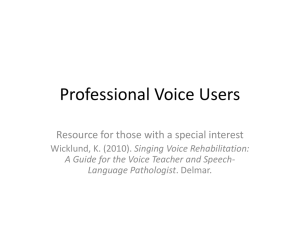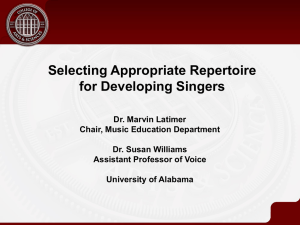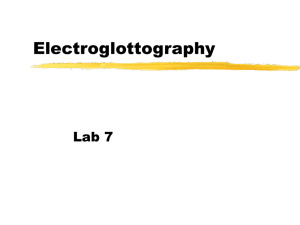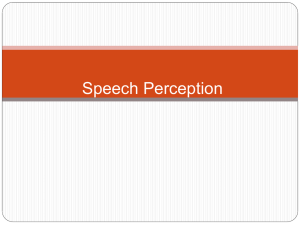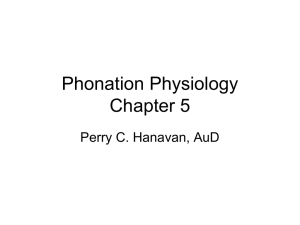File
advertisement
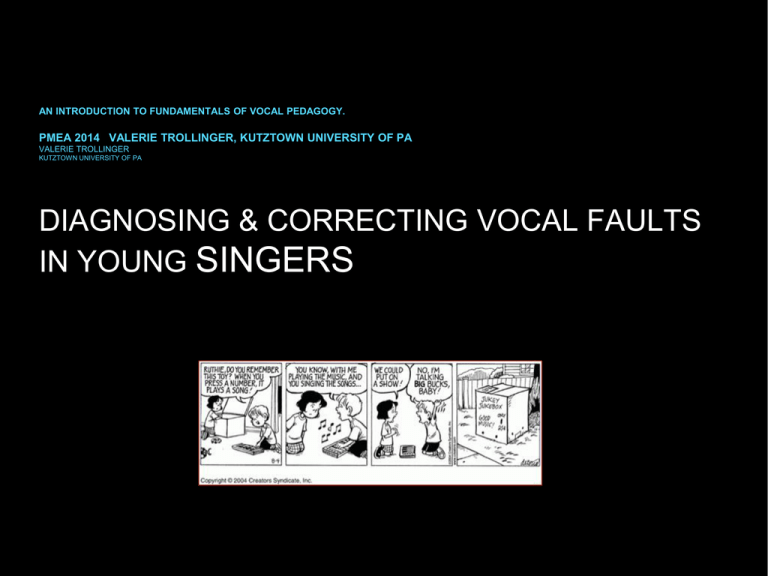
AN INTRODUCTION TO FUNDAMENTALS OF VOCAL PEDAGOGY. PMEA 2014 VALERIE TROLLINGER, KUTZTOWN UNIVERSITY OF PA VALERIE TROLLINGER KUTZTOWN UNIVERSITY OF PA DIAGNOSING & CORRECTING VOCAL FAULTS IN YOUNG SINGERS PURPOSE • Introduce you to common behavioral phonation issues that can be remediated. • Will not go into vocal issues concerning pathology or remediating problems that require ENT and Voice therapy specialists. WHY IS THIS IMPORTANT? • Functional vocal damage is on the increase in children. • Teachers tend to be prone to vocal damage. • Pre-service teachers have exhibited vocal damage prior to any vocal training. TEACHERS…( INCLUDING INSTRUMENTAL TEACHERS) • Need to have healthy voices • Need to demonstrate health vocal behavior • Should have vocal training. • a teacher with an unhealthy voice or with vocal issues will not be an effective teacher or coach of young voices. TERMINOLOGY TO BE USED IN THIS WORKSHOP… • Hyperfunction — the mechanism works excessively • Hypofunction— the mechanism works weakly, inefficiently. • Pathological • Behavioral-functional • Resting Larynx position while singing and speaking THE SINGING PROCESS • Requires a person to: • be able to hear and process pitch • replicate the pitch with the voice • self-monitor is the produced pitch is correct and created healthfully COMMON PROBLEMS • Poor posture • Inefficient breathing • Phonation issues • Hard glottal attacks • Breathiness • Loss of range after a few minutes • Misuse of heavy vocal adjustment COMMON PROBLEMS • Getting over the register break (not for younger children). • Articulation problems • Nasality POSTURE PROBLEM POSTURE • Remediation strategies • When seated, back is not tense • When standing, bottom is gently tucked under to help alignment, but not tightened • Feet are placed a bit apart • Think of the body as a marionette INEFFICIENT BREATHING • Remediation: • Front, back and sides are all engaged in breath support for singing • Three stages of healthy breathing for singing: • Inhale, Suspend, Exhale PHONATION • Breath needs to be under control for good phonation • Constricted, shouty and breathy sounds can be remediated by learning the three stages of healthy phonation for singing: • Attack, Sustain, Release. BALANCED ONSETS • Harsh glottal attacks can be avoided by putting a soft “h” sound at the front of vowels (attack = hattack). • Follow the steps for phonation as well. OVERALL CONCERNING PHONATION: • With young singers, be vigilant for: • raised shoulders • students who try to sing phrases that are too long ( especially younger students) • efficient breathing • students who try to consciously control the diaphragm muscles. • All of the above will lead to excessive tension and hyper function of the vocal mechanism. WHAT ABOUT HYPO FUNCTION? • One of the most prevalent faults, can persist through adulthood. It is the result of failure of appropriate activity of the laryngeal structure. • Clues — • Breathy air is able to escape via inadequate glottal closure. CORRECTING HYPOFUNCTION • Hum with mouth closed and teeth touching. This will feel buzzy. • Hum while moving the teeth apart, mouth still closed. • Imitate an opera singer • Vocalizing on forward vowels ( oh, ooo) with a B or Z in front. HYPERFUNCTION • Excessive demands put upon the larynx, results in sounds that is often described as being pressed ( Sundberg). • In young singers, this often happens when they try to sing too low or too high with improper adjustments. • Results in excessive tension. Hard glottal attacks are also a sign of hyperfunction. CLUES OF HYPERFUNCTION • Straight- tone singing ( after puberty) • Hoarseness • Loss of range after singing for only a few minutes • Speaking or singing above or below optimum pitch • Screaming, shouting, yelling • Habitually singing or speaking too loudly • Postural tension and rigidity. • Hard glottal attacks REMEMBER • Hyperfunction can result in vocal damage, requiring the services of a physician. CORRECTING HYPERFUNCTION • Learn balanced onsets • voice therapy techniques: yawn-sign, chant-talk • vocalize with consonants to free the jaw • Vocal Yoga techniques…. NEW APPROACH • Integrating all three — posture, breath, and phonation……Vocal Yoga POSITION 1 POSITION 2 POSITION 3 POSITION 4 POSITION 5 POSITION 6 RANGE LOSS • Temporary, not permanent loss • Occurs when singing with excessive tension in the vocal mechanism. • Remediated by: • “yawn-sigh” exercise • vocalize on consonants to free the jaw, phonate with forward vowels on B and Z. BEFORE WE GO TO REGISTER CHANGES…. • Your voice has several registers, not all are used in singing. • The term refers to distinct configurations of the structure of the vocal mechanism, resulting in a specific definable sound and vibratory pattern. The registers are: • Pulse register • Modal register- used for singing and speech • Loft Register • (Sataloff, 1997) PULSE OR FRY REGISTER * Includes vocal fry or rattle *Vocal bands are thickened and very loose. * Unless you are a bass singing Russian opera, no use for this in singing (for our purposes) * You will hear vocal fry in speakers when the voice is tired. WHISTLE OR LOFT REGISTER • Has been referred to by some to be akin to the head voice in early research. It is not a head voice ( Sataloff, 1997). • Tension is increased to very high levels, vocal bands are thinned, barely touching. There is diminished vocal intensity. • Unless one is singing the Queen of the Night, and perhaps some Bellini or Donizetti, little use for this register in singing ( for students in schools). MODAL REGISTER • Register where singing and speech take place. • The vocal bands are engaged in vibration along the entire length of the bands, in periodic motion. • Beliefs run from each pitch being its own register to the belief the registration areas are divided. • Head and Chest voice terms - outmoded and incorrect. Current terminology is more precise: heavy adjustment and light adjustment. • Prior to puberty, children do not have the adjustments we have called “head” and “chest” in the past. They do not have the musculature in place for these adjustments to happen in the vocal mechanism ( Trollinger and Sataloff, 2001). • So, how to work with these events in changed voices… SIGNS OF MISUSE OF HEAVY ADJUSTMENT • Sound is perceived as being forced • Chin may be pulled in • Sound may be harsh • Sound may be too low • Vocal bands are often pressed and too much air is being forced through the mechanism. WHAT IS HAPPENING INTERNALLY • Larynx is often forced too low ( if pitches are too low and chin is pulled in) or is forced too high ( if pitches are high and chin is pushed out). • Too much of this can lead to vocal damage • These vocal behaviors can be remediated REMEDIATION OF HEAVY ADJUSTMENT MISUSE • Remediated by • Find optimal speech range area-but a student may think the voice is actually too high until it becomes normal. This is not using a “light adjustment.” It’s more of a mix. • Yawn -sigh exercise • Sing within a limited range, then widen as healthy habits develop • Vocalize on forward vowels and consonants to alleviate tension • Vocal yoga techniques REGISTER BREAK-THIS SLIDE WAS ACCIDENTALLY SKIPPED IN THE PRESENTATION… • For voices that are mutating or matured. • Lunge exercise while singing octaves, on forward vowels and consonants. • The lunge exercise is simple and effective. Start in a standing position, singing a note ( D or C is good). As you sing up the octave, take a step out in front and lunge as you sing higher. The motion of your body going downwards also keeps your larynx from elevating as you go up the octave. As you go back down the octave, step back to your regular standing position. • This is a very old and very effective pedagogical strategy. A simplified way is to bend your knees instead of doing a full lunge. • Eventually, you want to delete the lunge but students will become more comfortable with the physical sensation of going into a head voice. This exercise also works for men. A SIDE NOTE… • Traditional use of the Siren sounds with young, unmutated children: • Often does not use the lighter adjustment if the siren goes too high. • Instead, it is causing an elevated laryngeal position, not good for students and especially not for teachers (Sataloff). Elevated larynx also occurs when teachers try to sing in straight tone to sound like children. • If using sirens, use in limited range. ARTICULATION • Lips, teeth and tongue can interfere with the production of a nice sound and understanding of words. • Remediation: • sing in front of a mirror • enunciate silently to see if another person can lip-read the words • use consonants on warmups to loosen articulators • yawn approach for raised tongue NASALITY • Nasal singing indicates the soft palate is not raised properly, allowing air to escape out the nose. This is a resonance problem rather than a phonation problem. • Remediation • Using the yawn exercise • Open the mouth more • The voice should sound the same whether the singer is holding one’s nose closed or not. • Vocal yoga NOT WORKING? • Get professional help: School speech specialists. • These simple remediations work with voices that are already healthy. They won’t work for voices with sustained behavioral or pathological problems. CHECKING FOR UNDERSTANDING • How many “wrong” teaching strategies and vocal behaviors do you find with this teacher based on what you have just learned? • https://www.youtube.com/watch?v=uWt2YJCJleY FREE VOICE LESSON FOR MORE INFO • For full presentations (4) with demonstrations, go to • http://www.prenhall.com for Music in Elementary Education by J.Flohr & V. Trollinger. • My website for basic presentation today: • http://faculty.kutztown.edu/trolling AN INTRODUCTION TO FUNDAMENTALS OF VOCAL PEDAGOGY. PMEA 2014 VALERIE TROLLINGER KUTZTOWN UNIVERSITY OF PA TROLLING@KUTZTOWN.EDU HTTP://FACULTY.KUTZTOWN.EDU/TROLLING DIAGNOSING & CORRECTING VOCAL FAULTS IN YOUNG SINGERS
